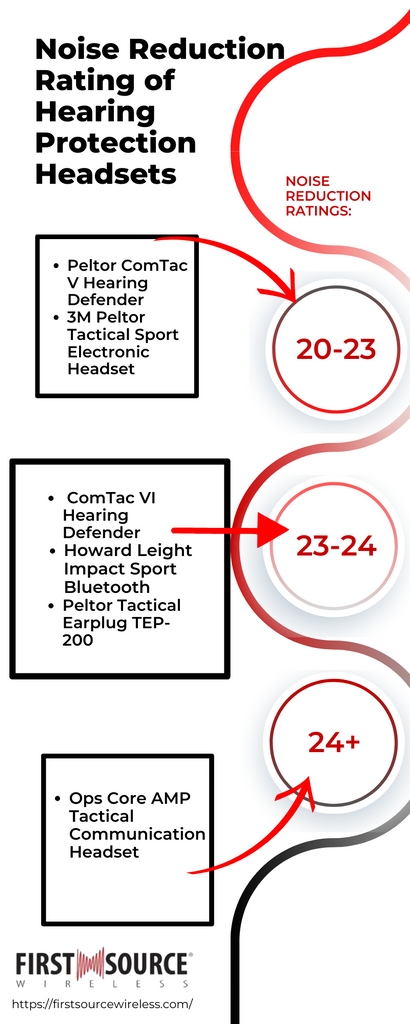According to the Cleveland Clinic, researchers found that 5.2 million children and teens between the ages of 6 to 19 and 26 million adults between the ages of 20 and 69 suffer from noise induced hearing loss. These statistics make up a staggering 9% of the American population.
Noise is one of the most common causes of hearing loss and occupational illnesses in the United States. The noise from gunfire is one of the most hazardous non-occupational noises.
A single gunshot heard by an unprotected ear can lead to immediate and permanent hearing loss, often accompanied by tinnitus or ringing, hissing or humming in the ears. A single shot from a shotgun, experienced at close range, may permanently damage your hearing in an instant.
Dr. Michael Stewart, Professor of Audiology at the University of Central Michigan and the American Speech-Language-Hearing Association, says that exposure to noise greater than 140 dB can permanently damage hearing, without protection. Almost all firearms create noise that is over the 140-dB level, says Dr. Stewart.
Firing guns in a place where sounds can echo or bounce off walls and other structures, like inside a building or some indoor shooting ranges, can make noises louder and increase the risk of hearing loss. Stewart goes on to say, “People who do not wear hearing protection while shooting can suffer a severe hearing loss with as little as one shot, if the conditions are right”.
Although you may have gone without shooting ear protection in the past, and bypassed apparent hearing loss, does not mean you might not damage your hearing the next time.
It’s important to wear hearing protection every time you shoot a gun to avoid possible hearing damage. Once your hearing is damaged, it won’t come back.
When using a firearm either to keep up with your law enforcement training requirements or for recreational purposes such as hunting, it is imperative to select the best shooting ear protection.
Why is hearing protection important?
- Hearing damage is often irreversible
- If you have damaged hearing while shooting you could miss instructions which can endanger yours and others lives (situational awareness)
What are the solutions?
- Avoid noises above 85dB for extended periods of time
- Use proper hearing protection like headsets and electronic earplugs (regular earplugs can hurt your situational awareness)
- Headsets and earplugs are the best option because limiting dangerous noise exposure is impossible when shooting firearms
What is NRR and why is it Important?
NRR stands for noise reduction rating. NRR is a measurement that determines how effective a hearing protection device, like a headset, is at reducing sound exposure. The measurement is taken after various tests by the Occupational Safety and Health Administration (OSHA) and the American Nation Standards (ANSI).
An average NRR for an over the ear headset can be anywhere between 20-31. Noise reduction rating is important because it determines if a particular headset will protect your hearing or not. If you are going to be around noise that is above 80-85 decibels, you should have protection.
If you are working on a construction site, the average decibels reached will be 110. If you have a headset with a 25 NRR then you will be back in a safe decibel range. Therefore, the louder the area you are in, the higher NRR number headset you will need.
Firearms tend to hit 165 decibels when fired which causes hearing damage. Consequently, hearing protection is a must especially when you are in an environment like a shooting range where firearms are going off consistently.
Noise reduction rating is just a part of the road to learning about hearing protection and preventing noise induced hearing loss.
We offer a wide variety of gun ear protection that is UL certified to prevent hearing loss.
Below are some images of suggested firearm hearing protection sets, along with the features of each electronic hearing protection device. All of the devices provide the best in class shooting ear protection!
Hearing Protection Options:
3M Peltor Tactical Sport Electronic headset:
The features of the 3M Peltor Tactical Sport Electronic headset add up to a great piece of technology that protects your hearing and your physical safety at the same time. For instance, the environmental microphones allow for face-to-face conversations and improved situational awareness in quiet and low to moderate levels of noise.
Moreover, with foam and liquid-filled cushions, the ear cups have an effective acoustic seal and are comfortable during long wear times. The adjustable headband also adds to the comfort levels because the headset can become an exact fit. Overall, the 3M Tactical Sport Electronic headset is built for protecting your hearing, comfort, and situational awareness making a great tool when shooting.
Features:
- Improved situational awareness from environmental microphones
- Foam and liquid-filled cushions
- Foldable and adjustable headband
- Black and orange outer shells included
- Price--$228.20
Pros:
- Accessible price
- Situational awareness
- Adjustable headband
Cons:
- Cannot be a comms headset
- No customization
Howard Leight by Honeywell New Impact Sport Bluetooth:
The New Impact Sport Bluetooth headset from Howard Leight is often a top choice for shooters looking to protect their hearing. It features unique elements like a folding design for compact storage, recessed controls, and snap-in ear cushions. The ear cushions are a great feature because it makes maintenance of your headset easy and can help it last longer in your care.
Features:
- Folding design—compact storage
- Recessed controls with a rifle cutaway for aiming
- Bluetooth controls and Bluetooth sync
- Separate volume controls
- Padded and adjustable headband with slim earcup
- Snap-in ear cushions
- Price--$154
Pros:
- Accessible pricing
- Bluetooth connection
- Compact storage
Cons:
- No environmental listening
- Cannot be a communications headset
3M Peltor Tactical Earplug TEP-200
The 3M Peltor Tactical Earplug TEP-200 offers hearing protection in a different style than the typical headset. Some shooters prefer earplugs because they feel they offer more freedom and comfort compared to headsets. The TEP-200 offers similar features when compared to the above headsets.
These earplugs include situational awareness technology and hearing protection. They are rechargeable with micro-USB and they are battery compatible if you are out in the field and do not access to a charging port. The choice between earplugs and headsets is up to the user, the most important factor is no matter the choice, your hearing is protected.
Features:
- Audio signal received wirelessly from neck loop accessory
- Hearing protection
- Environmental microphones for level-dependent hearing protection and situational awareness
- Rechargeable earpieces with micro-USB or 3 AA alkaline batteries
- Price--$624.51
Pros:
- Reasonable price
- Environmental listening
- Rechargeable
Cons:
- Not as secure hearing protection
- Cannot customize
Ops Core AMP Tactical Communication Headset:
The Ops Core AMP Tactical Communication Headset has a wide variety of features. The different quick release and change elements like the rail mount kit and downlead connection helps make the Ops Core AMP headset convenient and easy to use.
This headset also offers great hearing protection from ergonomic earseals. It also features a noise-cancelling microphone which helps create seamless communication. The Ops Core AMP Tactical Communication headset is a great choice for military use around gunfire. In the military, communication is key, so a headset that can maintain clear communication whilst protecting hearing around firearms is a great choice.
Features:
- 1 quick-release removable downlead connection
- 3D Hear-Through technology
- Mission configurable capability
- Ergonomic headband
- Quick-change rail mount kit
- Noise-cancelling microphone
- Ergonomic earseals
- Auto shutdown
- Fail-safe communications
- Removable boom mic so headsets can be used by left or right-handed shooters
- Price--$1,354.97
Pros:
- Comfortable to wear
- Quick customizations
Cons:
- High price
Peltor ComTac V Hearing Defender:
The 3M Peltor ComTac V has a variety of features including high fidelity speakers and omni-directional microphones. This headset was made to provide optimal hearing protection whilst maintaining s
Best Shooting Ear Protection
ituational awareness.
Features:
- Rubberized headband
- Can convert to ARC adapters
- Balance Mode
- Release time
- Volume boost
- Equalizer function
- Environmental listening
- High fidelity speakers
- Omni-directional microphones
- Price--$673.94
Pros:
- Great hearing protection
- Convertible headband
Cons:
- Higher price
- Cannot be a communications headset
Peltor ComTac 6 Hearing Defender:
The 3M Peltor ComTac 6 Hearing Defender was made to improve auditory performance in different environments. Peltor also made the ComTac 6 specifically for military workers making it the perfect headset for shooting ear protection.
This particular headset comes with a variety of features. The main difference between the ComTac V and ComTac VI is that the 6 comes with MAP or mission audio profiles. With this technology, users can set their headset to a certain environment to adjust the audio profile. The environments include: observation, patrol, conversation, comfort, and mic off.
Features:
- Noise Cancelling (IP68) Speech Microphone for Communication in Noise
- 350 hours of battery life
- Noise Reduction Rating of 23
- VOX hands-free push to talk
- Improved rubber head strap
- MAP function
- High fidelity speakers
- Omni-directional microphones
- Price--$798.97
Pros:
- Customizable audio profile
- Environmental listening
- VOX
Cons:
- High price
Comfort:
At the end of the day, even after reading through the information above, it can be challenging to see the differences between the headsets and determining which one is right for your purpose. A major deciding factor that buyers tend to ignore until after purchasing a headset is comfort.
This may seem like an unnecessary element to consider but it is important. If your headset is not comfortable, you simply will not wear it, especially if you are planning on being at the range for hours.
The two places to look for comfort on a headset are the earseals or earpieces and the headband. When the earseals are made out of gel, they tend to be more comfortable to wear all day. Headbands that are adjustable are also a plus because then you can fit your headset to the exact size you need.

Selecting the best shooting ear protection really is a matter of personal preference. Our knowledgeable staff has over twenty years of experience in reselling these trusted 3M Peltor shooting ear protection products. Please do not hesitate to call us at 800-991-4569 to determine which hearing protection options are best suited for you.
Have you experienced hearing damage before? Or are you looking to protect your hearing? Let us know in the comments below.
Updated April 13, 2022




